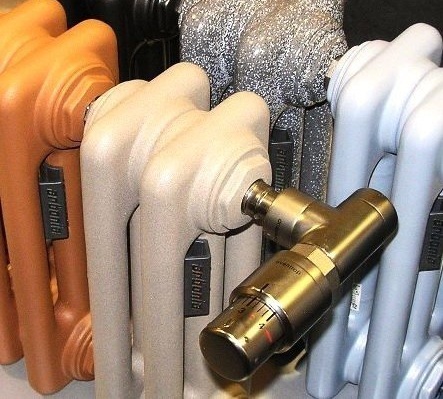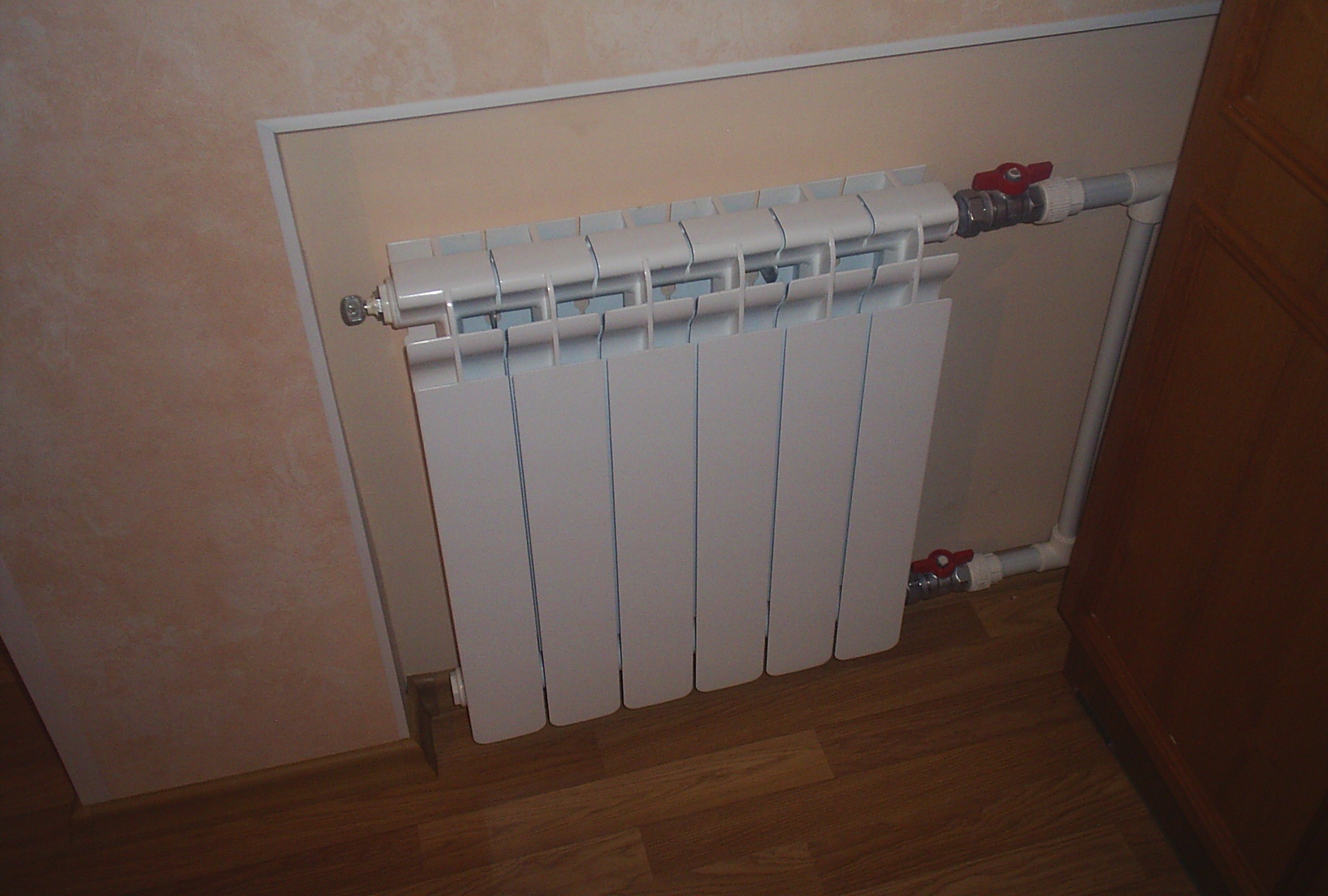How to choose a bimetal heating radiator: help for beginners in the "heating" business
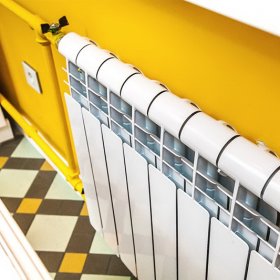
The cold season is a real test of the strength of heating systems. Unfortunately, not everyone can withstand it. In order not to be in cold weather without heat, care should be taken in advance about heating appliances and, in particular, about reliable radiators. In the construction market, you can find many different devices. However, many choose bimetallic heating radiators, despite the fact that their cost is slightly higher than that of other devices. What is the reason for this “uneconomic” decision? Let's get it together.
Content
How is this radiator arranged and how does it work?
The device is a combined device made of two metals. Most often this is steel and aluminum, but in the second case there may be other options. The inside of the equipment along which the coolant moves is made of steel. External or fins, not in contact with the coolant and serving to improve heat transfer, are made of aluminum. The main idea of using several metals in the manufacture of a heating device is the rational use of various structural and physical properties of these materials.
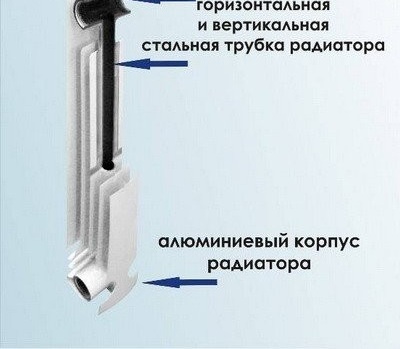
Two metals are used for the production of bimetallic radiators, which makes it possible to maximize the benefits of each material.
The use of steel in bimetallic structures is due to the following factors:
- Steel is resistant to pressure drops that occur in the heating system.
- Butt joints of the steel-steel type can better tolerate possible pressure increases in the system than similar aluminum joints.
- Steel is more resistant to electrochemical influences, while the internal surfaces of aluminum devices corrode and fail very quickly for this reason.
Aluminum, however, is characterized by a high thermal intrusion. This property can be regarded as its advantage, although in some ways it can be considered a disadvantage. Aluminum surfaces react very quickly even to small changes in temperature. This quality allows you to quickly adjust the temperature parameters of the room, which is possible with significant automation of the heating system.
High heat dissipation of aluminum makes it possible to use less coolantwhile the heat flux remains equivalent to the flux from cast iron radiators. Thus, the dimensions of the bimetallic radiator can be much smaller than that of the same cast iron, and the shapes are more attractive. The volume of liquid in one section of the device is on average about 150 ml.The main disadvantage of the high heat transfer of aluminum can be considered the increased load on the automation, which has to be turned off and on too often when the batteries cool down and warm up quickly.

The shape of the fins for a bimetallic radiator is very important. Correctly selected configuration allows you to maximize the trajectory of the path of cold air over a heated surface, which can significantly increase the efficiency of heating and distribute heat evenly
The shape of the fins is extremely important for the most efficient transfer of heat from the heating part of the radiator to the room. Actually, heat transfer occurs during the passage of cooled air masses through the fins of the radiator, which have a special configuration, developed taking into account experimental work and accurate calculations. The most difficult is the distribution of heated air after passing through heated surfaces and the capture of cold air masses. In this case, the trajectory of the air through the radiator should be extremely long, which can increase the efficiency of heat distribution by several times.
You may also find useful material on calculations and design of a heating system:https://aquatech.tomathouse.com/en/otoplenie/raschety/teplovoj-raschet-sistemy-otopleniya.html.
What to look for when choosing?
Despite the apparent simplicity of the device, bimetal heating radiators are structurally diverse. It is especially important to understand it, choosing radiators for your heating system. When choosing, it is important to consider several characteristics.
Battery design
There are two types of bimetallic systems: sectional and monolithic. The first are characterized by the presence of sections. These are elements made in the factory. Several of these parts, most often an even number, are combined into one radiator. Joints of sections are sealed with special gaskets mounted on nipples. The main advantage of the design is the ability to add or remove any number of sections if necessary, as well as replace a damaged part.
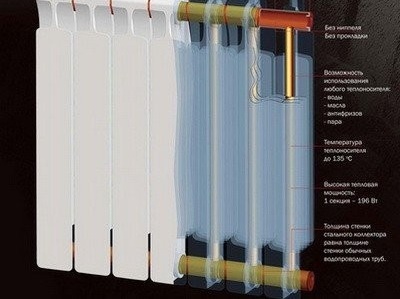
Monolithic models are distinguished by the absence of separate sections, which makes them especially resistant to sharp pressure drops in the system and some other advantages. However, the cost of such devices is slightly higher than that of sectional
The composition of the monolithic device includes a steel monolithic core, the strength of which far exceeds the similar detail in sectional models. On top of it is an aluminum shell. The main advantage of such devices is increased resistance to pressure drops. Choosing between sectional and monolithic devices, you should determine the working pressure in the system. If powerful hydroblows are possible - it is better to stop on monolithic radiators. In all other cases, sectional is preferable, since their cost is significantly lower.
To choose a reliable bimetallic radiator, you should know that two types of such devices are available. The first is made on the basis of a steel frame, while the second is equipped only with steel-reinforced channels through which the coolant flows. More reliable and durable are the devices of the first type. In them, the coolant does not come into contact with the aluminum alloy at all, which makes corrosion of the devices insignificant. Indirect signs indicating a bimetallic radiator of the first type are its weight and cost. Such devices are produced by the brands Royal Thermo BiLiner, Global Style, Rifar (Monolit model) and the domestic company Santechprom BM.
The second type of device is also called semimetal batteries. They are characterized by higher heat output and lower cost. However, for such devices, the degree of reliability of fixing steel tabs is extremely important.In some cases, due to the varying degrees of thermal expansion of steel and aluminum, they can move and block the lower collector. The most popular devices are the brands Gordi, Sira and Rifar, excluding the Monolit model.
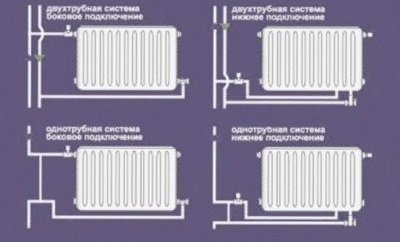
Bimetal radiators are quite simple to install and can be included in almost any existing circuit. The figure shows the possible options for connecting equipment
Distance between axles
Almost all models of bimetallic batteries are equally functional. However, in terms of the distance between the axes of the collectors, they can differ significantly. The standard interaxle values are considered to be 35 and 50 cm. If necessary, you can find models with non-standard values. Radiators with a minimum center distance of about 20 cm are manufactured by Sira, BiLUX and RIFAR. Models with a maximum axle spacing of 80 cm are manufactured by Sira.
Appearance
Traditionally, bimetallic devices are available for mounting on straight surfaces. However, if you need to install the device on a rounded wall, you can choose the necessary model in the RIFAR FLEX line, which differs in a non-standard configuration of heating devices. A special powder paint is applied to the radiators, providing a durable decorative protective layer. You can choose the color to your liking. For example, RIFAR and Sira products are distinguished by a bright white color, while Global prefers to produce radiators of muted milky tones.
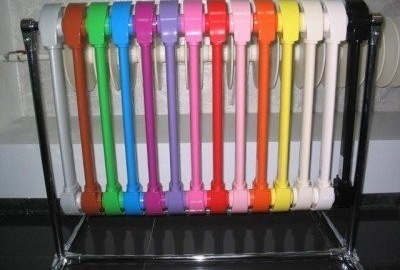
Heaters do not have to be white. If the style of decoration allows, it is quite possible to choose radiators of various colors
Bimetal heating devices can be not only direct, but also have the shape of an arc. You need to look for such devices in the lineup of the domestic manufacturer RIFAR.
Specifications
The technical characteristics of bimetallic radiators include the dimensions of the device. Their height can vary from 20 to 80 cm. The selection of the required sizes is quite simple, for this it should be subtracted from the distance between the bottom of the window and the floor 20 cm. The width of the device depends on the place of its installation. Pay attention to the working pressure. It can vary between 16-35 atmospheres. For centralized heating systems, it is recommended to select the maximum values, for autonomous ones - the minimum ones are suitable. The weight of the individual section is also important.
One of the main selection criteria is the power of the radiator. This value is determined based on the power of one section, which can be taken from the technical passport of the equipment. In the calculation take into account the quality of the insulation of the room, the location of the room and the number of windows. On this basis, from 50 to 120 watts will be required per square meter of space. In a simplified version, the calculations are carried out as follows: the room area is multiplied by the required power and the total power is obtained. To determine the required number of radiator sections, the resulting number is divided by the rated power of one section.
In addition to bimetallic radiators, there are aluminum, which also have many advantages. Read more about choosing such batteries in our article:https://aquatech.tomathouse.com/en/otoplenie/radiatory/alyuminievye-radiatory-otopleniya.html.
Why are bimetal batteries better than others?
Bimetal devices stand out among a number of similar devices with many advantages:
- Increased resistance to internal deposits of lime or rust. The smooth surface of steel or, in some models, copper does not trap debris that may be trapped in the coolant.
- High heat dissipation. Aluminum fins give off excellent heat. This indicator for bimetal is three times higher than that of steel batteries. Thus, thermal energy is spent more rationally.
- The light weight of the structure is much less than that of cast-iron or all-steel radiators. This property greatly facilitates the transportation and installation of equipment.
- The durability of the device. Only steel, which is much more resistant to aggressive media than aluminum, comes into contact with the coolant, and this is most often heated water.
- The life of the equipment without repair and additional maintenance, subject to proper installation, is about 20-25 years.
- Possibility of installation in centralized heating systems, since the devices can withstand a fairly high pressure and water hammer.
- Attractive appearance, which makes it possible to use them in any interior.
- The ability to adjust power by changing the number of sections.
The main disadvantage of bimetallic structures is traditionally considered their higher cost, which is due to the complex technology of their production. However, when you consider that these devices are reliable, economical and durable, it becomes clear that over time, the costs pay off.
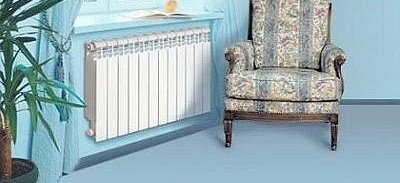
Bimetal devices are almost ideally suited for Russian operating conditions. They withstand frequent pressure drops in the system, are not demanding on the quality of the coolant and give off heat well
Are you planning to install heating pipes yourself? Then you may be interested in material with installation instructions:https://aquatech.tomathouse.com/en/otoplenie/radiatory/ustanovka-batarej-otopleniya-svoimi-rukami.html.
Bimetal radiators are reliable and practical equipment. They very successfully combined the best properties of steel and aluminum devices, while eliminating their basic shortcomings. For use in Russian conditions, such devices are almost perfect. They quite easily tolerate the presence of a large number of impurities in the coolant, as well as frequent sharp pressure drops in the system. Choosing heating equipment for your home, do not try to save money, preferring less expensive options. All of them have many shortcomings. Insignificant savings when buying can result in serious problems in operation and frequent repairs, while well-chosen and installed bimetal structures guarantee heat in the house for many years.
